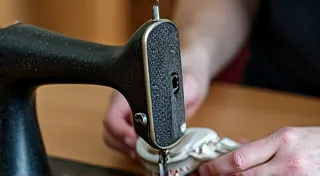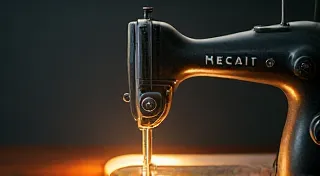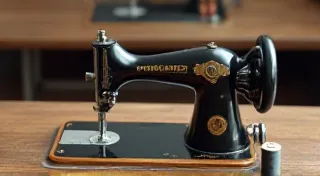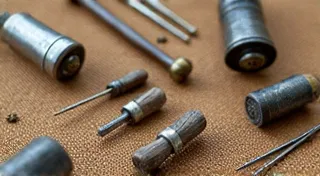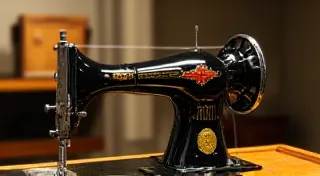Accessories to Complement Your Vintage Sewing Machine Collection
For the serious collector of vintage sewing machines, the journey doesn’t end with the machine itself. Truly appreciating these mechanical marvels requires understanding and preserving the entire ecosystem they existed within. This includes the accessories – the tables, cabinets, lamps, and various other items designed to enhance usability and add to the aesthetic appeal of these antique workhorses. Understanding and collecting these accessories significantly elevates the collecting experience and contributes to the preservation of sewing history.
The Importance of Accessories in Context
Imagine a beautifully restored 1950s Singer Featherweight without its original table. It’s a lovely machine, certainly, but a piece of its story is missing. Accessories weren't just decorative; they were functional necessities. They provided a stable work surface, proper lighting, and often incorporated storage for threads, bobbins, and tools. A machine sitting on a modern table simply doesn’t convey the same feel as one presented on its original, period-appropriate setup. Recognizing this is key to appreciating the true value of a vintage sewing machine and its supporting elements.
Tables: The Foundation of the Sewing Experience
Sewing machine tables were integral to the sewing process. They came in a wide variety of styles, from simple, functional wooden platforms to more elaborate designs featuring drawers, shelves, and even decorative elements. The construction materials varied as well; early tables were often made from simple planks of wood, while later models incorporated veneer, molding, and more refined joinery.
Types of Tables
- Original Tables: These are the holy grail for many collectors. Identifying the manufacturer and model year can be tricky, often requiring careful examination of markings, construction details, and hardware.
- Dealer Tables: Many sewing machine dealers provided tables specifically designed for their machines. These tables often feature the dealer’s name or logo, making them particularly desirable.
- Generic Tables: Many homespun or locally-made tables were used with sewing machines. While less valuable than dealer tables, these represent an important part of sewing history.
- Folding Tables: Particularly popular in smaller homes or for traveling seamstresses, folding tables offered portability and convenience.
Table Identification: Look for stamps, labels, or markings on the underside of the table. These can provide valuable clues about the manufacturer and model. Consider the style of the legs and the construction techniques used. Research online forums and collector groups to compare your table with known examples.

Cabinets: Protecting and Showcasing Your Machines
Cabinets offered a more enclosed and secure environment for sewing machines, protecting them from dust, damage, and curious children. They also provided a more polished and visually appealing presentation. Cabinet designs ranged from simple, utilitarian boxes to elaborate pieces of furniture with intricate carvings and hardware.
Cabinet Construction and Styles: Early cabinets were often made of solid wood, while later models incorporated veneer and decorative molding. Cabinet fronts frequently featured hinged or sliding doors, often adorned with decorative panels or stained glass. Some cabinets were designed to accommodate multiple machines, a boon for tailors and dressmakers.
Identifying Cabinet Manufacturers: Look for manufacturer’s marks on the cabinet’s interior or exterior. The style of the cabinet can also provide clues. Researching vintage furniture catalogs can help to identify the manufacturer and model year.
Lighting: Illuminating the Craft
Proper lighting was crucial for detailed sewing work. Sewing machine lamps became a standard accessory, providing focused illumination for intricate stitching. These lamps were often designed to be attached directly to the machine or placed nearby on a flexible arm.
Types of Sewing Machine Lamps:
- Original Lamps: These are highly sought-after by collectors, particularly those with the original shade and wiring.
- Dealer Lamps: Lamps bearing the dealer's name can significantly increase their value.
- Reproduction Lamps: While not as valuable as originals, reproduction lamps can be a practical option for illuminating your vintage sewing machine.
Lamp Shades: The lamp shade played a vital role in diffusing the light and preventing glare. Shades were typically made of fabric, metal, or glass. Original shades in good condition are rare and valuable.
Presses, Bobbin Winders and Other Essentials
Beyond the major accessories like tables and cabinets, a host of smaller items contributed to the sewing experience. These include:
- Ironing Presses: These specialized presses made pressing seams and garments much easier.
- Bobbin Winders: Essential for creating bobbins to fit the machine.
- Thread Stands: Held spools of thread and allowed the sewer to work hands-free.
- Needle Threaders: A helpful tool for threading needles, especially for those with less-than-perfect eyesight.
- Machine Oilers: Vital for keeping the sewing machine working smoothly.

Preservation and Restoration Considerations
When collecting vintage sewing machine accessories, preservation is key. Avoid harsh cleaning chemicals that can damage the original finish. When restoring accessories, prioritize reversibility – use techniques that allow for future restoration if necessary. Document your restorations thoroughly, including photographs and detailed descriptions of the work performed.
Building Your Collection
Collecting vintage sewing machine accessories can be a rewarding and enriching experience. Join online forums and collector groups to connect with other enthusiasts, share knowledge, and buy/sell accessories. Attend antique shows and flea markets to uncover hidden treasures. Remember, it’s not just about acquiring objects; it's about preserving a piece of sewing history and appreciating the craftsmanship of a bygone era.
Resources:
- Antique Sewing Machine Collectors of America (ASMCA)
- Online Sewing Machine Forums
- Vintage Sewing Machine Dealer Websites


